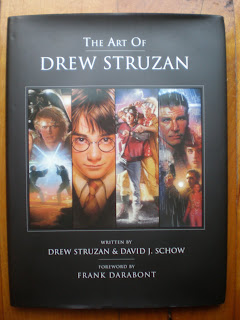It would be fair to say that I have been a big fan for many years, and that running the risk of being a gushing fan boy is a bit of a danger with this review. I don’t have enough superlatives to throw at it. I remember vividly, as a kid, STARING at my poster for Indiana Jones And The Last Crusade which hung above my bed and trying to work out if the picture was a photo or a painting. On close examination I noticed the small signature and upon the realisation that this had been PAINTED by a human being my mind was blown!
So here we have in one lovingly presented tome, a collection of Drew Struzan’s masterworks. Running the gamut of a rich and interesting career - in fact, it was only through reading this that I learned he has recently retired. The book is a treat. It is crucially also a great READ! Each piece of work selected for the book has an interesting tale to go along with it. It’s fun indeed to learn that Steve Guttenburg is a big Drew Struzan fan and collector of his work, or that Michael J Fox was thrilled to meet him when they worked on the Back to The Future trilogy. No surprise to learn that Guillermo Del Toro is a fan but nonetheless great to read about how he has the painting for Hellboy hanging in his house.
It kicks off in fine style with an introduction by Struzan’s friend and colleague, the esteemed Frank Darabont. It is fantastic. Darabont pulls no punches when it comes to his assessment of the decline in movie poster quality. It is a cantankerous, profanity laden foreword and benefits hugely from a large dose of the truth and a liberal useage of the word ‘douchebag’. Darabont laments the loss of artists like Struzan. He gives a good piece of his mind as to why movie posters these days are pathetic and, as he puts it, little more than a bunch of floating heads.
The book is presented chronologically and as the years pass, more and more of the passages reflect the fact that Drew’s stunning artwork was used less and less. It’s sad to read, but presents a fascinating, if demoralising insight into the processes of both artist and studio. There is some truly awe inspiring artwork in the latter passages of the book which barely ever saw the light of day. Take for example, the amazing poster for Hellboy. I always ALWAYS wondered why Drew Struzan’s art was never used. Particularly since the Region 1 dvd teases you by using it on the inside booklet. It is magnificent. The greater shame is that the actual poster ‘art’ in the UK (and I hesitate to call it art after reading Frank Darabont’s introduction) was just downright wretched. For my money the poster they used to promote Hellboy ranks as one of the worst movie posters I’ve ever seen. Apparently it was completely a studio marketing decision and not even Guillermo Del Toro, who as a fan of Struzan had commissioned him in the first place, could get the final say on using his painting!
A shame then also, that despite a sweet anecdote about how George Lucas was awed to meet Drew Struzan and was a huge fan, that the covers for all of the most recent Star Wars releases have eschewed Drew’s monumental artwork in favour of yet more photoshopped heads! At least Lucas (or more likely Spielberg) used his artwork for Indiana Jones and the Kingdom of the Crystal Skull. At the end of it all, Struzan’s poster was the only worthwhile thing to come out of that whole enterprise. The actual reading of this book therefore, is bittersweet. It’s full of many many fun stories but also, latterly, the charting of his disillusionment and disappointment with the industry, and what it seems was ultimately the reason behind his retirement.
It remains best to focus on the positives, of which there are many. For any fan of Drew Struzan, or any fan of the iconic movies to which he has lent his name this book is an absolute must. For any kid that stared at one of his movie posters trying to get his brain to comprehend if he was looking at a painting or a photo. For anyone with even a passing interest in the art of the movie poster or movies in general, the book is joy. Sit back and just marvel at what an extraordinary talent this man is.








No comments:
Post a Comment